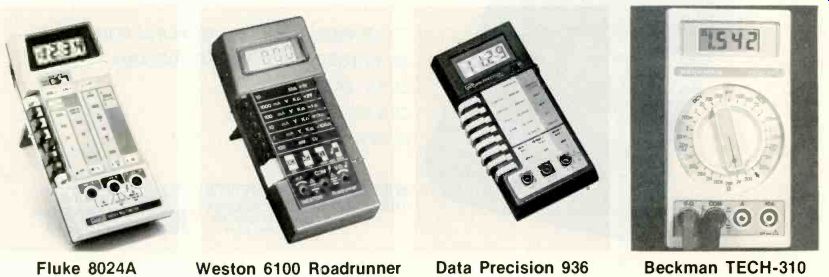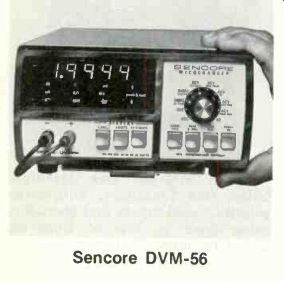By Carl Babcoke, CET
Digital multimeters have several advantages that make them superior to analog types. In the past, however, DMMs have had some limitations:
- The appreciable amount of time required to reach stable readings.
- The inability to properly handle any erratic resistance measurements or those of short duration.
- Digital readouts cannot follow peaks and nulls properly.
- The confusing, but normal, bobble of the least-significant digit.
Specific models of new digital multimeters have features that solve these problems. Descriptions of five DMMs that offer these improvements follow.
Fluke 8024A Fast-acting arrows supplement resistance tests. An open circuit across the test leads activates an up-pointing arrow located in the readout area. After the usual delay, the overrange indication appears on the digital readout. With any resistance range, a resistance or short circuit condition that continues for 50145 or longer activates the down-pointing arrow and sounds a 2kHz tone. After another normal delay, the resistance measurement appears on the digital readout. If the continuity time is brief, a pulse stretcher lengthens the audible tone to a 100mS burst.
The up-pointing arrow is activated by voltages higher than the +0.8V internal reference, while the down arrow is turned-on by voltages lower than the reference. Both arrows are visible when dc voltages alternately become higher and lower than the reference. This action can identify dc digital pulses or other kinds of dc-voltage variations.
A unique peak-hold feature can be switched on for any dc or ac voltage or current readings that otherwise would reach maximum and then decrease before the read out could respond. If the peak condition persists for 150mS or longer, the 8024A DMM displays the maximum voltage or current level. It continues to show the reading after the probes are disconnected. One digit of the reading then decays each second, allowing adequate time for the measurement to be observed. This can show various starting surges of current or the charging voltage of a capacitor (readings now attempted by the swing of analog pointers).

----- Fluke 8024A Weston 6100 Roadrunner Data Precision 936 Beckman TECH-310
Weston Roadrunner Model 6100 was named Road runner because of the beep-beep sounds produced during resistance or dc-voltage functions in the audio-response mode. The Road runner is a six-function portable DMM.
Data Precision 936
The beep indication of continuity operates from resistances within the three lowest resistor ranges, when used in the high-power mode. At the start of continuity, a 300mS beep is emitted.
This is an indication, not a measurement. It does not interfere with conventional resistance measurements. The function is useful when it is not convenient to watch the readout.
Excessive voltage applied to any function or range produces an audible alarm signal.
Beckman TECH-310
An ohms symbol in the upper left corner of the digital readout is activated almost instantaneously after continuity (or a resistance within the selected range) is established.
Rapid shorts and opens are correctly identified by this symbol, even when the signal changes too fast to permit any readout on the digital display.
Sencore DVM-56
The DVM-56 offers a choice of 4 1/2-digits, 4-digits or 3-digits. The number of visible digits can be reduced and eliminate the bobble of the least-significant digit, when full accuracy is not required.
For voltage ranges, a pushbutton selects the peak-and-null mode which lights an up-pointing arrow for increasing readings, or a down pointing arrow for readings that are decreasing. When a reading is steady, both arrows are activated.
The low point of a null or the high point of a peak can be located easily, with the digital readout later showing the numerical result.
This model is microprocessor controlled, which allows an automatic cancelling of test lead resistance when low-value resistances are to be measured.
Other features include a choice of peak-to-peak, average, or true RMS ac voltage. Automatic reading of decibels is provided.

------------- Sencore DVM-56
Also see: Comparison of VOMs, VTVMs and DMMs